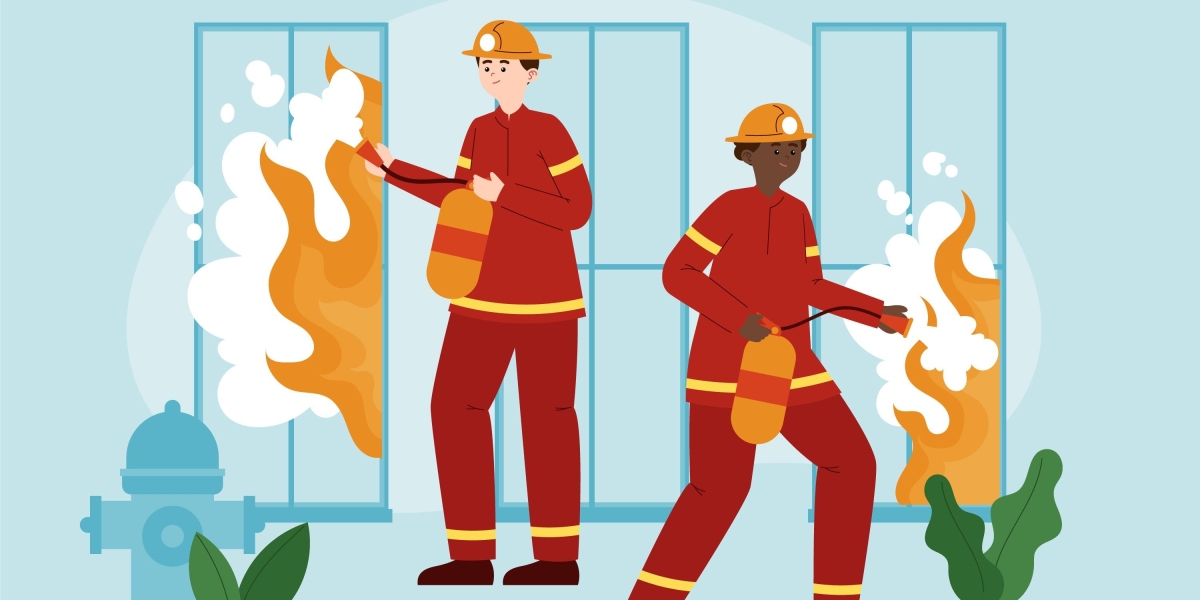Fire safety is an essential aspect of maintaining a safe environment, whether in residential, commercial, or industrial settings. The importance of a thorough fire risk assessment cannot be overstated, especially in densely populated areas like London, where the stakes are high. This comprehensive guide will walk you through the intricacies of fire safety risk assessment, from understanding its importance to implementing best practices that ensure safety and compliance.
Introduction
Fire safety is not just a regulatory requirement; it's a critical component of any safety strategy. A fire can cause significant harm to people, property, and the environment. Moreover, in urban settings like London, where buildings are often in close proximity, the risk of fire spreading quickly and causing widespread damage is a serious concern. This makes conducting a fire risk assessment survey an indispensable part of any safety protocol.
A fire risk assessment is a systematic process of identifying fire hazards, evaluating the risk they pose, and implementing measures to reduce or eliminate those risks. In London, businesses and property owners are legally required to conduct regular fire safety risk assessments to comply with the Regulatory Reform (Fire Safety) Order 2005. However, beyond legal compliance, the primary goal of a fire risk assessment is to protect lives and property.
This article will delve into the guidelines and best practices for conducting a comprehensive fire safety risk assessment. We will explore the various aspects that need to be considered, from identifying potential fire hazards to ensuring that your safety measures are up-to-date and effective. Whether you're a business owner, a property manager, or a safety officer, this guide will equip you with the knowledge you need to conduct a thorough fire risk assessment.
Understanding Fire Risk Assessment
A fire risk assessment is a process that involves a systematic evaluation of the factors that could lead to a fire, the likelihood of such an event, and the potential consequences. The primary objective is to identify fire hazards and take appropriate measures to minimize or eliminate the risk of a fire occurring.
What Is a Fire Risk Assessment?
At its core, a fire risk assessment survey involves several key steps: identifying potential fire hazards, determining who might be at risk, evaluating the risk of fire, and implementing control measures to reduce or eliminate those risks. It's not just about ticking boxes; it's about ensuring that every possible risk is identified and mitigated.
The Legal Framework
In London, and indeed across the UK, fire safety is governed by the Regulatory Reform (Fire Safety) Order 2005. This legislation requires that all non-domestic premises undertake regular fire risk assessments. Failure to comply can result in severe penalties, including fines and imprisonment.
Why Fire Risk Assessment Is Crucial
The importance of a fire safety risk assessment cannot be overstated. Not only is it a legal requirement, but it's also a critical component of any safety strategy. A thorough fire risk assessment can help prevent fires, save lives, and protect property.
Identifying Fire Hazards
One of the first steps in a fire risk assessment survey is identifying potential fire hazards. This involves a detailed examination of the premises to identify anything that could start a fire, as well as anything that could fuel a fire or cause it to spread.
Common Fire Hazards
Fire hazards can come in many forms, from faulty electrical equipment to flammable materials. Some common fire hazards include overloaded electrical circuits, improper storage of flammable materials, and poor housekeeping practices that allow rubbish and debris to accumulate.
Evaluating the Risk
Once potential fire hazards have been identified, the next step is to evaluate the risk they pose. This involves assessing the likelihood of a fire occurring and the potential consequences if it does. This evaluation should consider factors such as the layout of the building, the number of occupants, and the effectiveness of existing fire safety measures.
Risk Reduction Strategies
After identifying and evaluating the risks, the next step is to implement measures to reduce or eliminate them. This could involve removing or reducing the hazards, improving fire safety equipment, or implementing new procedures and training for staff.
Implementing Fire Safety Measures
Once the fire hazards have been identified and evaluated, it's time to implement fire safety measures to mitigate the risks. These measures should be designed to prevent fires from occurring and to minimize the impact if a fire does occur.
Fire Detection and Alarm Systems
One of the most critical fire safety measures is the installation of fire detection and alarm systems. These systems are designed to detect the presence of fire and alert occupants so they can evacuate safely. In London, it's a legal requirement for many buildings to have a fire detection and alarm system in place.
Fire Extinguishers and Firefighting Equipment
In addition to fire detection and alarm systems, it's essential to have the right firefighting equipment on hand. This includes fire extinguishers, fire blankets, and hose reels. It's important to ensure that this equipment is easily accessible and that occupants know how to use it.
Fire Safety Training
Another crucial aspect of fire safety is ensuring that all occupants are trained in fire safety procedures. This training should cover how to use firefighting equipment, how to evacuate the building safely, and what to do in the event of a fire.
Fire Safety Risk Assessment in London
London presents unique challenges when it comes to fire safety risk assessments. The city's dense population, historic buildings, and diverse architecture mean that a one-size-fits-all approach won't work. Instead, fire safety risk assessment London need to be tailored to the specific characteristics of each building and its occupants.
The Challenges of Urban Fire Safety
London's urban environment presents several challenges for fire safety. The close proximity of buildings means that a fire in one building can quickly spread to others. Additionally, the city's historic buildings may not have been designed with modern fire safety standards in mind, making them particularly vulnerable.
Tailoring Fire Safety Measures to London
Given the unique challenges of fire safety in London, it's essential to tailor fire safety measures to the specific characteristics of each building. This might involve upgrading fire safety equipment, improving evacuation procedures, or implementing additional fire safety measures.
Working with Fire Safety Professionals
Given the complexity of fire safety in London, it's often advisable to work with fire safety professionals who have experience in conducting fire risk assessments in the city. These professionals can provide expert advice on the best measures to take and ensure that your fire safety risk assessment is thorough and compliant.
Fire Safety Documentation and Record Keeping
Proper documentation and record-keeping are essential components of a comprehensive fire safety risk assessment. These records serve as proof of compliance with fire safety regulations and provide a reference for future assessments.
The Importance of Documentation
Documentation is a critical aspect of fire safety risk assessment. It provides a written record of the risks identified, the measures taken to mitigate those risks, and the procedures in place to respond to a fire. This documentation is essential for demonstrating compliance with fire safety regulations and for ensuring that fire safety measures are up-to-date.
What to Include in Your Fire Safety Records
Your fire safety records should include a detailed account of the fire risk assessment survey, including the hazards identified, the risk evaluation, and the measures implemented. Additionally, it's important to keep records of any fire safety training provided to occupants, as well as maintenance records for fire safety equipment.
Regular Updates and Reviews
Fire safety is not a one-time task; it's an ongoing process. It's essential to regularly review and update your fire safety risk assessment to ensure that it remains relevant and effective. This is particularly important in London, where changes to the building, its occupants, or the surrounding environment can significantly impact fire safety.
Best Practices for Conducting a Fire Risk Assessment
Conducting a fire risk assessment is a critical task that requires careful planning and execution. Following best practices can help ensure that your fire risk assessment is thorough and effective.
Involving the Right People
One of the keys to a successful fire risk assessment is involving the right people. This includes not only the person responsible for conducting the assessment but also other stakeholders, such as building occupants, maintenance staff, and fire safety professionals.
Taking a Systematic Approach
A systematic approach is essential for ensuring that no aspect of fire safety is overlooked. This involves following a step-by-step process, from identifying fire hazards to implementing safety measures and keeping detailed records.
Regular Training and Drills
Fire safety training and drills are essential components of a comprehensive fire safety strategy. Regular training ensures that all occupants know what to do in the event of a fire, while drills provide an opportunity to practice evacuation procedures and identify any potential issues.
The Role of Technology in Fire Safety Risk Assessment
Technology plays an increasingly important role in fire safety risk assessment. From advanced fire detection systems to digital record-keeping, technology can help improve the accuracy and efficiency of your fire safety measures.
Fire Detection and Alarm Systems
Modern fire detection and alarm systems are highly advanced, with features such as smoke and heat detectors, automatic sprinklers, and integrated alarm systems. These systems can provide early warning of a fire, allowing occupants to evacuate safely and reducing the risk of injury or death.
Digital Record-Keeping
Digital record-keeping is another area where technology can play a significant role in fire safety. Digital records are easier to update, store, and access than paper records, making it easier to keep your fire safety documentation up-to-date and compliant with regulations.
The Future of Fire Safety Technology
The future of fire safety technology is likely to involve even more advanced systems, such as artificial intelligence (AI) and the Internet of Things (IoT). These technologies have the potential to revolutionize fire safety, providing real-time monitoring, predictive analysis, and automated responses to fire hazards.
Fire Safety Compliance and Enforcement
Compliance with fire safety regulations is not just a legal requirement; it's a critical component of any fire safety strategy. Understanding the regulations and ensuring that your fire safety measures are compliant is essential for protecting lives and property.
Understanding Fire Safety Regulations
Fire safety regulations in London are governed by the Regulatory Reform (Fire Safety) Order 2005. This legislation requires that all non-domestic premises undertake regular fire risk assessments and implement measures to reduce the risk of fire. Failure to comply with these regulations can result in severe penalties.
The Role of Fire Safety Inspectors
Fire safety inspectors play a crucial role in ensuring compliance with fire safety regulations. These inspectors have the authority to inspect premises, review fire safety documentation, and issue enforcement notices if necessary. It's important to work with fire safety inspectors to ensure that your fire safety measures are compliant and effective.
Penalties for Non-Compliance
The penalties for non-compliance with fire safety regulations can be severe. In addition to fines, property owners and managers can face imprisonment if their failure to comply results in a fire. Ensuring compliance with fire safety regulations is not just a legal obligation; it's a moral responsibility.
The Future of Fire Safety Risk Assessment
As technology and regulations evolve, so too does the field of fire safety risk assessment. Staying ahead of these changes is essential for ensuring that your fire safety measures remain effective and compliant.
Emerging Trends in Fire Safety
Several emerging trends are likely to shape the future of fire safety risk assessment. These include the increasing use of technology, the growing importance of sustainability, and the need for more personalized fire safety measures.
The Impact of Climate Change
Climate change is likely to have a significant impact on fire safety, particularly in urban environments like London. As temperatures rise and weather patterns become more unpredictable, the risk of fire is likely to increase. Fire safety risk assessments will need to take these changing conditions into account.
The Importance of Ongoing Education and Training
Fire safety is an ever-evolving field, and ongoing education and training are essential for staying ahead of the curve. This includes not only regular training for building occupants but also continuing education for fire safety professionals.
Conclusion
Fire safety risk assessment is a critical component of any safety strategy. Whether you're a business owner, property manager, or safety officer, understanding the principles of fire safety risk assessment is essential for protecting lives and property. In London, where the risks are particularly high, conducting a thorough fire risk assessment is not just a legal requirement; it's a moral responsibility.
By following the guidelines and best practices outlined in this article, you can ensure that your fire risk assessment is comprehensive, effective, and compliant with regulations. Whether you're conducting the assessment yourself or working with fire safety professionals, the goal is the same: to create a safe environment where the risk of fire is minimized, and everyone knows what to do in the event of an emergency.
With the right approach, fire safety risk assessment can be more than just a regulatory requirement—it can be a powerful tool for protecting lives and ensuring the safety of your property. So take the time to conduct a thorough fire risk assessment survey, implement the necessary safety measures, and keep your fire safety documentation up-to-date. The safety of your building and its occupants depends on it.








